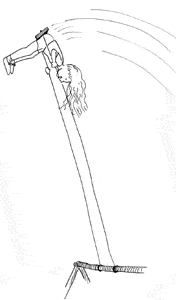Up, up, and... : Nobody flies over the swing-set

DRAWING BY DEBORAH DERR McCLINTOCK
Q. My visiting aunt became concerned that the kids on the swing-set were going too high and might swing all the way around... like she did as a kid. We don't believe her story. She insists she did a complete 360 around the top bar. Would it be possible for a kid to gain the momentum to do that? –R. L. Stevenson
A. The centripetal force would need to be at least equal to gravity to keep some tension in the chains at the top, which for chains 2 meters long would require the child to go at 4.4 meters/second at the top– not too fast, says Yale University mechanical engineering professor David LaVan. However, this would mean higher velocity at the bottom of the arc, which works out to be about 10 meters/second (22 mph)– or about the speed of an Olympic sprinter. So: conceivable but unlikely.
The real deal-breaker is that she would be subjected to quite high centripetal forces– about 6 G's if going fast enough to make it all the way around. An aircraft pilot will black out when exposed to 4-5 G's. So, unless the person relaying the story had both 1) a catapult to propel her at 10 meters/second and 2) a NASA issued anti-gravity suit to prevent blackouts, "I would conclude that it is not something that really happened."
Quite possibly she reached a dizzying height, allows LaVan, lost her grip and fell off the swing backwards, making it seem like she went all the way around.
Q. Using every number from 1-16, construct a 4-by-4 "magic square" where all rows add up to 34 horizontally, vertically and diagonally. BTW, a famous artist depicted this particular magic square in a 1514 etching. –Sudoku
A. The matrix of 16-3-2-13 (top), 5-10-11-8, 9-6-7-12, 4-15-14-1 (bottom) appears in the upper right-hand corner of Albrecht Durer's etching "Melancholia I," where a melancholy thinker sits lost in thought amid a jumble of scientific objects, says Clifford A. Pickover in Wonders of Numbers."
Fascinatingly, the two central numbers of the bottom row read 1514, the year Durer did the etching. In addition to rows and diagonals, the four corner numbers and the four central numbers sum to 34. Rounding out the marvels here, even the sum of each of the four quadrants is 34 (e.g., 16 + 3 + 5 + 10 = 34), making it a "gnomon magic square," notes Mathworld.wolfram.com.
Q. Should a risk of 1 on the Torino scale cause us Earthlings the night sweats? However you answer, you might want to jot down 2029 as one of those pay-attention dates. –Mr. Spock
A. Torino is a sort of Richter scale for cosmic collisions, quantifying the risk of our being hit by an asteroid, with 0 being completely harmless and 10 a certain collision with possible global catastrophe, says New Scientist magazine.
Which brings us to 2029 and asteroid Apophis, 300-400 meters across, enough to take out a large city. This object was spotted in 2004, with NASA giving it a scary 4 on the Torino scale (greater than 1 chance in 50 of hitting Earth). Recalculations since suggest it will be a near miss instead at about 25,000 km from Earth's surface. But this close call will likely change Apophis' course, maybe tugging it to swing back around for a possible Earth hit in 2036, rating a 1 on the Torino scale.
One problem is scientists don't know enough about asteroids. Are they mostly solid, riddled with voids, or made of loose rubble? If we try to blow one up Hollywood-style, what happens? Maybe it would be better to send a probe to spray paint it white, causing greater force from solar radiation to gently push it off course, suggests the magazine.
"The 2029 approach is the closest a moderately large asteroid is likely to come during the next century," says Harvard astronomer Brian Marsden, "and regarding the possible hit in 2036, most likely we'll know by 2013 that this one too will be a clear miss."
Q. It was another one of those days: The fat guy didn't eat all that much but expended barely 1/7th horsepower as a "couch potato" in front of the TV. The other guy, heavier than the first, consumed plenty for the day– three orange juices, five eggs over easy, eight ounces of hash browns, a big rib-eye breakfast steak, two candy bars for morning snack, a couple of helpings of lasagna, two coleslaws, six buttered rolls, two quarts of Gatorade, three apples, three pork chops, two baked potatoes with cheese sauce, three bananas, a big ice-cream sundae, two slices of peach pie, and a dish of low-fat yogurt sprinkled with artificial sweetener for a midnight snack, totaling 10,000 calories. Yet the first guy added weight while the second added not an ounce. Guess how. –J. Craig
A. On football game day, players the size of Anthony Munoz or Lawrence Taylor can easily burn off the rough equivalent of the above menu, says physicist Timothy Gay in Football Physics: The Science of the Game. Assuming 50 plays for an offensive lineman and 21-22 horsepower-seconds per play, that's 1,100 horsepower seconds, or close to 200 food calories.
But this doesn't factor in the body shifting into higher gear metabolically, so the burn-off continues well after the mechanical work stops. In addition, there's the grunting standoff push-on-push where nothing seems to move mechanically, but in fact the players' muscles contract and relax and do ample force-through-distance work. Lots of food for thought.
Send Strange questions to brothers Bill and Rich at .